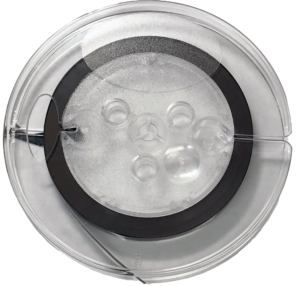Legacy Audio to mp3
Transfer and Copy to mp3 Your LP, 78rpm & Transcription records, Audio Cassettes, Micro and Mini Cassettes, Magnetic Steel Wire, and Reel-to-Reel Tapes
Highest Quality Transfers and Restorations
Why W. Cardone
W. Cardone Productions has the latest technology to copy your legacy audio transfer to MP3. We offer options for mastering records to, in many cases, make them vastly superior to the original. This is especially true with our transfer of vinyl records, including LP record albums, 78rpm, and 16″ transcription records. Even records having had the greatest care and stored under optimum conditions will have rumble, pops, crackles, and hiss. Audio copied from records having broken tracks is repaired as well. These restoration services are included with each record transfer and copy to mp3 that we do.
For reel-to-reel ¼” tapes, we accept formats recorded in 1-track monaural, 2, and 4-track stereo. In addition, we also accept tapes recorded in a 4-track quadraphonic stereo format.
Standard 4-track stereo records a 2-track stereo signal in a forward direction and a second pair of 2-tracks in the reverse direction. The quadraphonic format however records all 4-tracks in the forward direction. It therefore produces signals for four discrete speakers: front left and right; and rear left and right. Reels as large as 10½” and speeds up to 15 inches per second are accepted.
Note that we pay special attention to the periodic calibration and maintenance of our machines using laboratory standard calibration tapes supplied by Magnetic Reference Laboratory, Inc. of San Jose, California, or GennLab in New Zealand. Head alignment, equalization, tape transport speed, and line signal calibration figure highly in the success of duplication to digital accurately reproduce the original audio with full fidelity. It is also important during a periodic calibration to check and adjust, if necessary, braking and motor torques to guarantee fragile legacy magnetic tape is not stressed.
A CD media release is available on request for a nominal fee. We use professional grade CDs of the highest longevity costing roughly three times what is available to the consumer at retail outlets, and is certain to last for decades. The audio quality of pro-grade CDs is no different than that of consumer-grade. Consumer-grade CDs/DVDs, on average, will only be playable for 10 years.
We are equipped to process extremely large quantities of media (hundreds and literally thousands) typically used by radio stations for broadcast archival. This includes audio cassettes, digital audio tapes (DAT), and the MiniDisc.
Please call for details on what specific capabilities exist and for pricing and delivery on CD media. If you choose to use a credit card we use wireless chip reader technology at your door for maximum security.
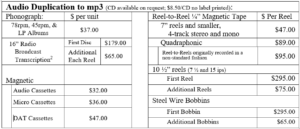
Audio Transfer
LPs
The LP was a 12- or 10-inch fine-grooved disc made of vinyl and played with a smaller-tipped “microgroove” stylus at a speed of 33 1/3 rpm. Each side of a 12-inch LP could play for more than 20 minutes.
45s
Under typical circumstances we do not duplicate 45 rpm phonograph records to digital. There are two reasons for this. First, it is a virtual certainty that any legacy 45 rpm record will have already been beautifully duplicated to CD and available at Amazon for a fraction of what we would charge. The second reason is they are almost universally copyrighted.
78 rpm Records
Any flat disc record, made between about 1898 and the late 1950s and playing at a speed around 78 revolutions per minute is called a “78.” Generally 78s are made of a brittle material which uses a shellac resin.
Radio Transcription Records
Radio and television stations in the 1940s (before the advent of quality magnetic tape audio) used phonographs to record audio for playback on air. The phonograph records they used however were of a quality far beyond the consumer grade phonograph records commonly in use at that time. These “transcription records” were cut at 33 1/3 rpm and were 16” in diameter. The fact they were cut at such a slow speed and had a very large surface area allowed them to hold whole half-hour radio shows including commercials. In addition, the grooves were finely cut further aiding in adding available time per record.
Consider also that transcription turntables were manufactured solely for radio and TV as opposed to the consumer market. This meant that the market would sustain quality features. One quality feature commonly found on transcription turntables was a strobe light timing system whereby a precise turntable speed could be dialed in by the user without any additional instrumentation. This was important because a total playing time for any given record would therefore be assured so that on-air production was possible.
The overall quality of these records was astounding for that day. Transcription records we receive today at W. Cardone Productions (recorded 70 years ago) play back with incredible clarity rivaling the quality of modern LP records. The only catch is that the records are too large to play on modern turntables. A transcription turntable is required.
Audio Cassettes
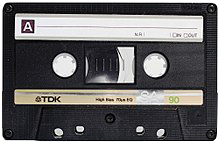 The audio cassette was introduced into the consumer market by Phillips in 1963 and was a smash hit. It was still in common use until about the year 2000.
The audio cassette was introduced into the consumer market by Phillips in 1963 and was a smash hit. It was still in common use until about the year 2000.
Micro Cassettes
 The Micro audio cassette was generally used in portable hand-held audio recording and also in telephone message recording machines. Shown in this picture, it is compared with the standard size audio cassette so that you may understand its size.
The Micro audio cassette was generally used in portable hand-held audio recording and also in telephone message recording machines. Shown in this picture, it is compared with the standard size audio cassette so that you may understand its size.
MiniDisc
 This particular audio technology (magneto-optical) was first invented in 1983 but it was 10 years later before the concept entered the consumer market. Sadly, the MiniDisc never took off in the United States for consumer use. However, it did find widespread use among musicians and radio stations.
This particular audio technology (magneto-optical) was first invented in 1983 but it was 10 years later before the concept entered the consumer market. Sadly, the MiniDisc never took off in the United States for consumer use. However, it did find widespread use among musicians and radio stations.
At W. Cardone Productions, we are equipped to duplicate very large numbers of MiniDisc media in a timely fashion. MiniDisc projects typically come in from radio station archives and number in the hundreds and the thousands.
Magnetic Wire Recording
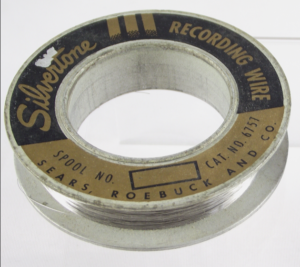 This media was the predecessor of the venerable magnetic tape recording technology. The media itself was a steel wire so thin that it is actually very difficult to see an individual strand. The bobbin it winds onto with wire is shown in the photo. The mechanical technology behind this media is absolutely incredible. The recorder/player transports the wire from the bobbin to the takeup reel with almost unimaginable precision. The problem was that because the wire is so thin, if the wire does not distribute perfectly evenly as the transport occurs, a wire strand will be pulled underneath another strand and a snag will develop making further use of the reel virtually null. To make a perfectly distributed winding possible, an articulating play/recording head was used. You have to see it to understand it so we will leave it at that.
This media was the predecessor of the venerable magnetic tape recording technology. The media itself was a steel wire so thin that it is actually very difficult to see an individual strand. The bobbin it winds onto with wire is shown in the photo. The mechanical technology behind this media is absolutely incredible. The recorder/player transports the wire from the bobbin to the takeup reel with almost unimaginable precision. The problem was that because the wire is so thin, if the wire does not distribute perfectly evenly as the transport occurs, a wire strand will be pulled underneath another strand and a snag will develop making further use of the reel virtually null. To make a perfectly distributed winding possible, an articulating play/recording head was used. You have to see it to understand it so we will leave it at that.
At W. Cardone Productions, we are equipped to duplicate very large numbers of these magnetic steel audio recording media in a timely fashion. This media requires playback equipment that has been precisely conformed to the manufacturer specifications. Anything else puts your legacy media at risk.
Digital Audio Tape (DAT)
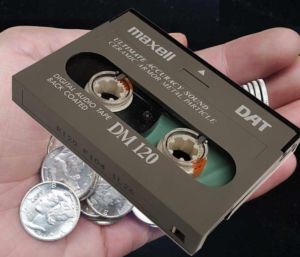 The digital audio tape, or DAT, is somewhat smaller than the audio cassette easily fitting in the palm of one’s hand. But a standard size DAT cassette holds a full two hours of audio recording. This one would have entered the consumer market except that the music industry made special provisions that it would never make it. Had the DAT entered into widespread consumer use, it would have likely killed the recording industry or at least crippled it. However, the DAT cassette did find widespread use for archival of radio station broadcasts. Consequently, when a DAT order comes in here at W. Cardone Productions, it is on the order of hundreds of cassettes.
The digital audio tape, or DAT, is somewhat smaller than the audio cassette easily fitting in the palm of one’s hand. But a standard size DAT cassette holds a full two hours of audio recording. This one would have entered the consumer market except that the music industry made special provisions that it would never make it. Had the DAT entered into widespread consumer use, it would have likely killed the recording industry or at least crippled it. However, the DAT cassette did find widespread use for archival of radio station broadcasts. Consequently, when a DAT order comes in here at W. Cardone Productions, it is on the order of hundreds of cassettes.
Reel-to-Reel including 4-track 10½" Reels
Audio recording to magnetic tape was invented literally by accident in the early 1940s but only made to compete with other media for extremely high quality in the mid 1960s. Its easy ability to re-record over and over and for relatively long durations made it extremely attractive for consumer use.